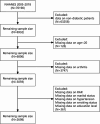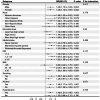Red blood cell distribution width to albumin ratio is associated with osteoarthritis prevalence among US adults with diabetes using data from NHANES 2005 to 2018
- PMID: 40595875
- PMCID: PMC12219024
- DOI: 10.1038/s41598-025-05686-7
Red blood cell distribution width to albumin ratio is associated with osteoarthritis prevalence among US adults with diabetes using data from NHANES 2005 to 2018
Abstract
The aim of this study was to assess the relationship between red cell distribution width and albumin ratio (RAR) inflammatory markers and prevalence of osteoarthritis in a diabetic population by analyzing data from the National Health and Nutrition Examination Survey (NHANES). Using data from 2005 to 2018, using multivariate logistic regression, generalized additive models, and smooth curve fitting, we investigated the connection between RAR and osteoarthritis in diabetic individuals. Robustness checks included subgroup analyses. A total of 2698 participants were included in this study, in which the prevalence of osteoarthritis was 24.20%. After controlling for variables, multivariate logistic regression analysis revealed a significant and positive correlation between RAR levels and the prevalence of osteoarthritis (OR = 1.52, 95% CI: 1.24, 1.88). Smoothing curve analysis showed a significant nonlinear relationship between RAR levels and the prevalence of osteoarthritis (log likelihood ratio test P < 0.05). Threshold effect analysis showed an inflection point of 3.69 for RAR, and to the left of the inflection point, the OR for prevalence of osteoarthritis was 2.61 (95% CI: 1.77, 3.83) for each unit increase in RAR; interaction analyses showed that the variables did not have a significant effect on this relationship (p > 0.05 for all interactions). Elevated RAR is associated with an increased prevalence of osteoarthritis in diabetic patients. This study supports the hypothesis of an association between RAR and osteoarthritis in the U.S. diabetic population, and diabetic individuals with elevated RAR levels should be particularly aware of their increased risk of developing osteoarthritis.
Keywords: Cross-sectional study; NHANES; Osteoarthritis; RAR; Red blood cell distribution width to albumin ratio.
© 2025. The Author(s).
Conflict of interest statement
Declarations. Competing interests: The authors declare no competing interests. Conflict of interest: The authors declare no conflicts of interest. Ethical statement: The portions of this study involving human participants, human materials, or human data were conducted in accordance with the Declaration of Helsinki and were approved by the National Center for Health Statistics (NCHS) Ethics Review Board. The relevant protocol numbers were Protocol #2005-06 (approved in 2005), Protocol #2011-17 (approved in 2011 and continued in subsequent cycles), and Protocol #2018-01 (approved in 2018). The patients/participants provided their written informed consent to participate in the study. Detailed information about the ethical review and consent process is available on the NHANES website ( https://www.cdc.gov/nchs/nhanes/irba98.htm ).
Figures
Similar articles
-
Red cell distribution width/albumin ratio as a marker for metabolic syndrome: findings from a cross-sectional study.BMC Endocr Disord. 2024 Oct 25;24(1):227. doi: 10.1186/s12902-024-01762-7. BMC Endocr Disord. 2024. PMID: 39455980 Free PMC article.
-
The association between red blood cell distribution width-to-albumin ratio and chest pain prevalence in US adults: A cross-sectional analysis of NHANES 2005-2018.Medicine (Baltimore). 2025 Jul 4;104(27):e43200. doi: 10.1097/MD.0000000000043200. Medicine (Baltimore). 2025. PMID: 40629632 Free PMC article.
-
Association of overactive bladder with red cell distribution width to albumin ratio in American.Sci Rep. 2025 Jul 28;15(1):27395. doi: 10.1038/s41598-025-13129-6. Sci Rep. 2025. PMID: 40721625 Free PMC article.
-
Systemic pharmacological treatments for chronic plaque psoriasis: a network meta-analysis.Cochrane Database Syst Rev. 2021 Apr 19;4(4):CD011535. doi: 10.1002/14651858.CD011535.pub4. Cochrane Database Syst Rev. 2021. Update in: Cochrane Database Syst Rev. 2022 May 23;5:CD011535. doi: 10.1002/14651858.CD011535.pub5. PMID: 33871055 Free PMC article. Updated.
-
Signs and symptoms to determine if a patient presenting in primary care or hospital outpatient settings has COVID-19.Cochrane Database Syst Rev. 2022 May 20;5(5):CD013665. doi: 10.1002/14651858.CD013665.pub3. Cochrane Database Syst Rev. 2022. PMID: 35593186 Free PMC article.
References
-
- Hunter, D. J. & Bierma-Zeinstra, S. Osteoarthritis[J]. Lancet (London England). 393 (10182), 1745–1759 (2019). - PubMed
-
- Martel-Pelletier, J. et al. Osteoarthritis[J] Nat. Reviews Disease Primers, 2: 16072. (2016). - PubMed
-
- Lo, J., Chan, L. & Flynn, S. A systematic review of the incidence, prevalence, costs, and activity and work limitations of amputation, osteoarthritis, rheumatoid arthritis, back pain, multiple sclerosis, spinal cord injury, stroke, and traumatic brain injury in the united states: A 2019 Update[J]. Arch. Phys. Med. Rehabil.102 (1), 115–131 (2021). - PMC - PubMed
MeSH terms
Substances
Grants and funding
- 2022BEG03156/Key R&D Project of Ningxia Hui Autonomous Region
- 2022BEG03156/Key R&D Project of Ningxia Hui Autonomous Region
- 2022BEG03156/Key R&D Project of Ningxia Hui Autonomous Region
- 2022BEG03156/Key R&D Project of Ningxia Hui Autonomous Region
- 2022BEG03156/Key R&D Project of Ningxia Hui Autonomous Region
LinkOut - more resources
Full Text Sources
Medical




